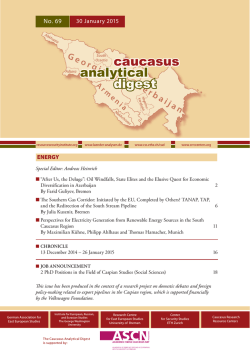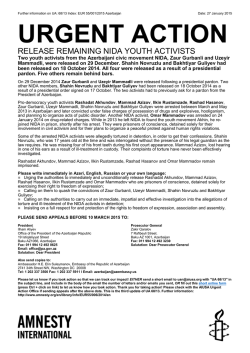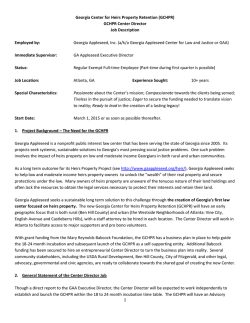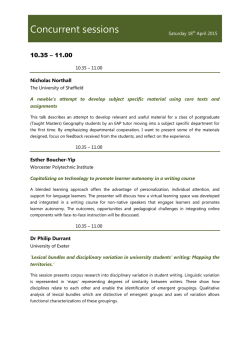
A broken region: evaluating EU policies in South Caucasus
A broken region: evaluating EU policies in South Caucasus – Analysis 29.01.2015 Eurasia Review/ US/ Jos Boonstra & Laure Delcour http://www.eurasiareview.com/29012015-broken-region-evaluating-eu-policies-southcaucasus-analysis/ The Caucasus is a broken region. Armenia, Azerbaijan, and Georgia have chosen different paths for political and economic development, while Turkey and Russia – which can also be considered part of the Caucasus – have very different ties with these three states. In addition, the Caucasus is divided between its southern part of three independent republics and a northern Caucasus, which is part of Russia. Caucasian borders have (to various degrees) emerged as obstacles to cooperation, movement of people, and trade. For the European Union (EU), this fragmented landscape is challenging. The Union likes to think in terms of well-defined regions with regional cooperation leading to integration. In the Balkans (which was another broken region), all countries have been seeking eventual EU membership (at different speeds and with mixed results) and the EU has been able to help foster regional cooperation as part of the terms for accession. This is unlikely to happen in the South Caucasus, where the EU is not the only game in town and Russia aggressively seeks to maintain its influence. Over the past few years, the simultaneous deployment of two mutually exclusive projects – the Deep and Comprehensive Free-Trade Areas (DCFTAs) offered by the EU as part of its Eastern Partnership (EaP) and the Russian-led Eurasian Economic Union (EEU) – has only exacerbated differences in the South Caucasus. Since the Vilnius EaP summit in November 2013, Georgia (like Moldova and Ukraine) has come significantly closer to the EU by signing an Association Agreement (AA) alongside a DCFTA. Neither of the other two South Caucasus countries is likely to conclude similar agreements in the near future, albeit for different reasons. Armenia has become a member of the EEU, which entered into effect in January 2015, while Azerbaijan has so far not engaged into any legally-binding economic integration project. What does all this mean for the EU’s approach – foremost through the EaP – in the South Caucasus? And how can the EU factor in these differences into coherent bilateral and multilateral policies? Can the EU play a positive role in helping to ‘fix’ this broken region? BEHIND A BROKEN REGION: DIVERGING NATIONAL PATHS AND INTERESTS Armenia, Azerbaijan, and Georgia have diverse foreign policy priorities and domes c reform processes herefore it is perhaps unsurprising that they have di erent expecta ons vis- -vis the EU. In addition, their engagement in regional projects driven by either the EU or Russia is not clear-cut or irreversible, but fraught with multiple tensions. Over the past few years, Georgian attitudes towards the EU have shifted as a result of both regional and domestic developments. During the early years of the Saakashvili presidency (he was in power from 2004-2013), despite a rhetorical emphasis on the country’s European identity, integration with the EU was not a key priority; instead, membership in the North Atlantic Treaty Organisation (NATO) was. The 2008 conflict with Russia – which resulted in the de facto loss of Abkhazia and South Ossetia while also putting an end to the hopes of NATO accession in the short run – marked a turning point. Despite lingering resistance to some EU regulations (caused by the then authorities’ liberal economic agenda) the conflict put closer links with the EU at the top of the Georgian agenda. Building on the progress made under Saakashvili, the current government seems to be speeding up its regulatory alignment with EU acquis (rules and practices). Furthermore, alongside some attempts at normalising relations with Russia, the incumbent government has remained firm in its pro-EU choice, and domestic political developments have so far not jeopardised the country’s course For Georgia the EU’s EaP has two major flaws First it falls short of offering any prospect of membership and the recognition of Georgia as an ‘Eastern European country’ in the 2014 Association Agreement is of little consolation. Second, the EaP offers nothing to address Georgia’s immediate security concerns For example the November 2014 ‘ reaty on Alliance and Strategic Partnership’ between Russia and Abkhazia triggered suspicion and concern in bilisi but the EU could do nothing more than reiterate its support for Georgia’s territorial integrity. The newly tabled treaty with South sse a goes a step further in gran ng Russia full control over that Georgian territory Georgia therefore views modernisa on la EU as a model of development, and thus a means to buttress its independence in the long term. In the short run, Tbilisi is only too aware of the EU’s inability to counter Moscow’s stronghold over Abkhazia and South Ossetia, and any further attempts by Russia to encroach upon Georgian territory. Whereas Armenia recently chose to join the Russian-led EEU, Yerevan had earlier also welcomed the EU’s enhanced offer under the EaP he 2008 conflict in Georgia and a failed rapprochement with Turkey made the country more vulnerable, while lingering tensions following the divisive 2008 presidential elections triggered a sense of urgency for greater economic modernisation Armenia’s interest in the EaP has translated into adoption of EU trade-related standards and even completion of negotiations for a DCFTA. Location and extent of the former Nagorno-Karabakh Autonomous Oblast (lighter color) However Armenia’s engagement with the EU is complicated by the simmering NagornoKarabakh conflict with Azerbaijan, since Yerevan depends on Russian support to deter Turkishbacked Baku. During 2013, Russia started increasing its pressure on Armenia to join the Eurasian Customs Union (forerunner of the EEU) – an option initially ruled out by Yerevan. As a result, Armenia accommodated Russian requirements at the expense of EU-inspired reforms. However Armenia’s relationship with Russia is complex as illustrated by both the large number of exemptions sought by Yerevan during EEU negotiations and the recent anti-Russian demonstrations following the tragic killing of an Armenian family by a Russian soldier in Gyumri. Despite EEU accession, the Armenian authorities have sought to preserve links with the EU to the greatest extent possible. While EEU membership and a DCFTA are mutually exclusive, Armenia is keen to conclude an agreement that would reflect improved relations with the EU – ideally, an AA without a trade component. However this is unlikely to be easily accepted by the EU since Yerevan’s 2013 U-turn generated disappointment and mistrust in Brussels, and tailor-made bilateral arrangements would take time to develop within the current rather stringent EaP format. Thus far, Azerbaijan can afford the luxury of not aligning with the EU – including prescriptions on human rights and democracy – or submitting to Moscow’s will through the EEU (and other Russia-driven organisations) he country’s vast wealth of oil and gas has resulted in the firm establishment of an authoritarian regime that maintains an iron rule at home and advertises its economic progress abroad. Initially, Baku seemed open to some reforms inspired by Brussels and competed with Yerevan on receiving better marks in annual EU reports. Yet the ruling elite soon gave up on political reform and tightened control over society as the country’s economic growth skyrocketed First the political opposition was marginalised, followed by repressing independent journalists over the last five years, and more recently by a purge against independent non-governmentalorganisations (NGOs) and think tanks Whereas the country’s relations with the EU will remain modest, Brussels and Baku have different views on their substance. Azerbaijan focuses on energy cooperation while the EU wants a stronger emphasis on democracy and human rights. However, in contrast to its sanctions on Belarus the EU is not prepared to consider sanctions against Azerbaijan, unless mass violations of human rights take place. This can be explained by three interwoven factors. First, the EU is less concerned about developments in a country that is not a direct neighbour and has no desire for membership. Second, the EU views Azerbaijan as a future alternative to Russia for gas supplies. Yet, even though the volume of Azerbaijani gas supplied to Europe could increase by 2019 if the Trans-Anatolian Natural Gas Pipeline (TANAP) pipeline is built, it will be dwarfed by Russian, Norwegian, and Algerian deliveries. Last but not least, the country is an interesting partner to the EU (and the US) from a geostrategic perspective. Like neighbouring Iran, Azerbaijan is Shiite, yet moderate and secular, and is ethnically and linguistically close to (NATO member) Turkey. Nonetheless, Azerbaijan (as well as Armenia) poses a severe security threat to the Caucasus region and indirectly to Europe because of the Nagorno-Karabakh conflict. Despite many similarities with other protracted conflicts in the post-Soviet space, this conflict differs in the sense that Russia is an indirect actor that cannot fully control either side. Whereas peace talks have made some progress over the last decade, the risks of a new war have not diminished. In this context the EU’s feeble security clout in the region makes Brussels a secondary actor at best. THE EASTERN PARTNERSHIP IN THE SOUTH CAUCASUS: TIME FOR A REALITY CHECK Launched in 2009, the EaP has offered new opportunities for South Caucasus countries to develop their relationship with the EU. On a bilateral basis, the main accomplishment of the EaP in the region has been the conclusion of an AA and DCFTA with Georgia. Moreover, all three countries are aiming for (albeit at different speeds) visa liberalisation, which also requires substantial reforms in key areas such as migration management or the fight against corruption. Georgia may get a visa-free regime this year, while Armenia may progress toward a visa liberalisation action plan. Azerbaijan is further behind, but visa facilitation and readmission agreements signed with the EU are in force. With the EaP, the EU has emerged in the South Caucasus as an agent for domestic change (at least in Georgia, to some degree in Armenia and to a much lesser extent in Azerbaijan). But EU-inspired change has its limits, as the EU is only as influential as South Caucasus states allow it to be. Reforms often remain shallow and local elites carefully calculate the high short-term costs against longer-term (and vaguer) benefits. At the same time, by making its AA/DCFTA offer the main bilateral ‘take-it-or leave-it’ package the EU has put itself in a difficult situation So far, no plan B has been developed for countries that seek deeper relations with the EU but no AA or DCFTA. he EaP’s multilateral track is also in need of revision as it is incapable of handling the growing differences between South Caucasus countries in their relationships with the EU. At the political level, the work of the multilateral track is affected by regional tensions and conflicts. For instance the work of the EaP’s parliamentary dimension (Euronest) has often been paralysed by divergences between Armenia and Azerbaijan. Standard bilateral European Parliament Delegations with South Caucasus (or East European) countries would be more practical as is already the case with Moldova, Ukraine and soon Georgia. At the technical level thematic groupings (officially known as ‘platforms’ – the backbone of the multilateral track) are mainly EU-driven and their content primarily reflects EU concerns. The platform on economic integration is a blatant example of this. The emphasis on approximation with EU trade regulations is relevant to Georgia, but less so to Armenia and Azerbaijan. Other platforms (for example, on democracy, good governance, and stability) also inspire uneven interest among the three partners. However, the multilateral track does offer a useful framework for representatives of the three EU partners to meet. Regional tensions and conflicts feed into high-level meetings, but thematic platforms and panels provide fora where officials from Armenia, Azerbaijan, Georgia and East European states can discuss their respective reform experiences. In addition, the nongovernmental formats (the Civil Society Forum, the Business Forum) have fostered contacts between South Caucasian societies Meanwhile the EaP’s six flagship projects – from integrated border management to environmental governance – need careful evaluation. Fruitful projects should be continued and strengthened, while those that have not produced results after five years should be either reformed or scrapped. Even though results are likely to be modest and mostly long-term, in essence the multilateral track should help build confidence between the participating countries. For the EU, the multilateral track also offers a forum to explain its policies and to provide an alternative narrative to Russia’s policies In the post-Soviet space Russia has highly problematic relations with some countries (foremost Georgia and Ukraine), while its EEU initiative does not meet much enthusiasm among current and potential members. Here the EU has an advantage as it can bring all countries together. The EaP multilateral track, therefore, has potential, subject to internal review and discussion with EaP partners regarding their preferences. THE WAY AHEAD The South Caucasus is a broken region with severe internal and external blockades to regional cooperation, which will require the EU to prioritise bilateral approaches to the region. Relations should be increasingly country-tailored, taking into account the needs of both the EU and its partners. The multilateral approach to the six EaP countries can be an additional asset if focused on confidence building, possibly complemented by a few cross-border projects with mixed participation. It is in the EU’s interest that the Caucasus becomes a stable and democratic region. But the EU has little influence to make this happen without two currently missing ingredients: a much more substantial engagement on security challenges and a clear for its Eastern partners. The Russian authoritarian model will keep traction as it pretends to solve the shortterm worries of some of these states and to safe-guard the incumbent regimes. At the very least, the EU should be ready to fully support those countries that do opt for in-depth political and economic reforms. Such an approach would not prevent the EU from setting democracy and human rights benchmarks with authoritarian states such as Azerbaijan. The EU should also increasingly focus on linking EU member-state societies to those of the South Caucasus. This requires shifting its policy paradigm from narrow legal and technical approximation to broader societal integration, for instance through people-to-people contacts. Europe’s attractiveness remains high – also in Armenia and Azerbaijan – and in the long run will be more influential than short-sighted Russian propaganda. Civil society cooperation (including through the Civil Society Forum), visa liberalisation policies, and support to educational exchanges have been overshadowed by the EU’s focus on AA/DCF A negotiations However, societal links should be turned into both a key priority in current relations and a basis for a deeper long-term partnership. he EaP sought to help stabilise the EU’s South Caucasus neighbours but lacked a security component from the outset. Neither a harder security posture from the EU, nor success in settling protracted conflicts in the South Caucasus (without Russian involvement and agreement), are on the table. The current EU engagement in security matters is largely confined to the Common Secu- rity and Defence Policy (CSDP) border monitoring mission in Georgia (EUMM) and the participation of an EU Special Representative in the Geneva talks between Georgia and Russia. Besides stepping up EU engagement through NATO and the Organisation for Security Cooperation in Europe (OSCE) at the Minsk talks concerning Nagorno-Karabakh, there is little more the EU can do. Specific Caucasus security strategies by the EU would seem overambitious since member states – for a variety of reasons – will likely not support heavier involvement in the region’s security Nonetheless the region’s protracted conflicts remain volatile and inflammable. However, the EU could more strongly support the reform of the security sectors of those countries willing to engage for instance by assisting in reforming partners’ police border guards, judicial systems, and democratic oversight mechanisms. This should be possible in Georgia (and already undertaken to some degree), and it could be worthwhile to investigate such options with Armenia and Azerbaijan perhaps by linking it to confidence building measures between both adversaries. Furthermore, there are elements of security sector reform (SSR) in the EU’s visa liberalisation policies with Caucasus countries as these affect some aspects of the police, border guards and judicial systems; this can potentially be an entry point for broader SSR engagement. CONCLUSION The ongoing fragility and fragmentation of the South Caucasus will not be fixed anytime soon as the region is prone to domestic instability inflammable protracted conflicts and Russia’s heavy influence. The EU will not (and cannot) ix the Caucasus region, but it can have a positive bearing on its development, provided that it can design a clearer and firmer long-term vision. The EU should seek to play a responsible and more active security role in the South Caucasus by being prepared for further problematic relations with Russia, and being ready to cope with a shifting, complex, and uncertain domestic and regional environment. Also, the EU will need to adopt a more flexible bilateral approach complemented by renewed multilateral cooperation for- mats via the EaP. Last but certainly not least, given its attractiveness to South Caucasus societies, the EU should place societies and people-to-people contacts at the core of its policies in all three countries. *About the authors: Jos Boonstra is head of the Eastern Europe, Caucasus and Central Asia programme atFRIDE Laure Delcour is scientific coordinator and research fellow of the EU FP7 CASCADE project at the Fondation Maison des Sciences de l’Homme Source: he research for this paper is funded by the European Union’s Seventh Framework Programme (FP7/2007-2013) under grant agreement n° 613354 – CASCADE Project. www.cascadecaucasus.eu This article was published by FRIDE as POLICY BRIEF – No 193 – JANUARY 2015 (PDF)
© Copyright 2025








